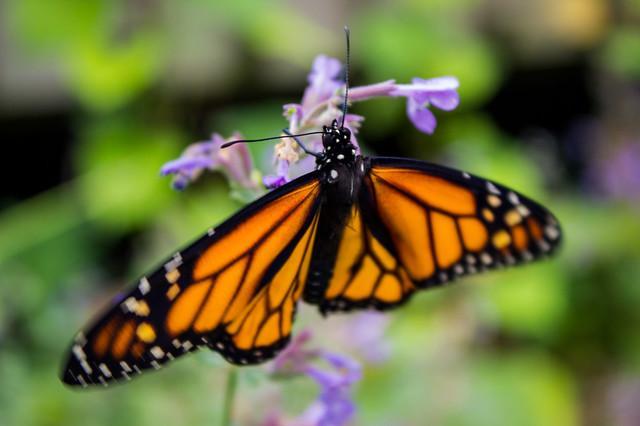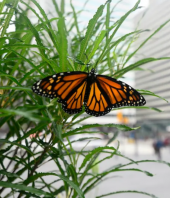Scientists across the country are scrambling to understand why monarch butterflies are disappearing at such an alarming rate as the U.S. Fish and Wildlife Service considers listing the butterfly as endangered.
North America's largest population of monarchs, which migrate between Mexico and the Midwest, has fallen 80 percent, from a billion in the 1990s to 200 million in 2018.
A smaller monarch population in the western United States that migrates between California and the Pacific Northwest is disappearing even faster, dropping from 1.2 million in the 1990s to just 30,000 last year -- a 98 percent drop.
"That is a catastrophic decline," said Tierra Curry, a senior scientist at the Center for Biological Diversity, which is based in Arizona. "They might not be able to bounce back."
Faced with those numbers, the Fish and Wildlife Service is several years into a massive review of North America's butterflies to determine if they qualify for federal protection under the Endangered Species Act.
"We have a species status assessment team that is modeling threat evaluations," said Georgia Parham, a spokeswoman for the Fish and Wildlife Service's Midwest office, which is leading the review.
"We're are also soliciting evaluations from monarch experts, and we've also launched a monarch database that anyone can enter information into," Parham said.
The agency plans to announce its findings in December 2020.
But many scientists say conservation efforts cannot wait that long. Groups like the Center for Biological Diversity, which petitioned the service to list the monarchs as endangered in 2014, and the Monarch Joint Venture are spearheading conservation programs based on the latest available science.
That science, they are quick to admit, is incomplete.
Scientists cannot say for certain why monarchs are dying. Several unrelated phenomena could be killing them.
"There are several hypotheses for the decline, all of which are probably contributing to some degree," said Andrew Myers, a doctoral student at Michigan State University's Department of Entomology who studies monarchs.
Finding precise causes are difficult, in part because monarchs are migratory insects.
They clump together on tree branches in the mountains of Mexico to hibernate during the winter -- turning those forests orange. When it warms, they fly north to lay their eggs on milkweed plants growing throughout the Midwest.
They can then travel as far north as Canada in search of the nectar from flowering plants. And when the weather turns cold, they return to Mexico.
Climate change might be disrupting their long migrations, Meyers said. Urban sprawl could be choking out flowering plants. And the Mexican forests in which the insects overwinter are being logged, which undoubtedly is a threat to their survival.
"Any one of those things is enough to wipe out the monarch population," Curry said.
But the timing of the eastern population's decline could be the most telling, she said, because it seemed to begin around the same time as the first herbicide-resistant crops were introduced to U.S. agriculture.
These crops were genetically engineered to survive the application of certain herbicides, allowing farmers to spray those chemicals on their fields and kill off other plants without harming their crops.
One of the plants these herbicides are especially effective at killing is milkweed -- the sole food monarch butterfly larvae can eat.
"What happens to milkweed in the Midwest is incredibly important to the monarch population," said Ian Kaplan, a professor of entomology at Purdue University.
Researchers at Iowa State University and the University of Minnesota in 2013 estimated nearly 60 percent of the milkweed had disappeared from the Midwest landscape since 1999. That decline coincides with an increase in herbicide resistant crops.
Monsanto introduced the first herbicide-resistant soybean plant, called RoundUp Ready soybean, in 1996, followed by a RoundUp Ready corn in 1998. Today, about 90 percent of the corn and 94 percent of the soybeans grown in the U.S. are herbicide resistant, according to the U.S. Department of Agriculture.
"The monarch butterfly did fine in croplands before RoundUp Ready crops," Curry said. "That allowed more RoundUp to be sprayed, and that killed more milkweed in agricultural fields."
Many of the monarch conservation efforts revolve around planting more native milkweed in public spaces, parks, private lands and on the edges of agricultural fields in hopes those plants replace those lost to agriculture.
But it is unclear how big of an impact that is having because scientists still don't understand how other factors -- like pesticide use -- contribute to the insects' decline.
With that in mind, entomologists like Kaplan are devising new studies every year to obtain a more detailed picture of what is happening to monarch larvae in their shrinking habitat.
Kaplan recently conducted a study at Purdue that measured the volume of pesticides present on wild milkweed growing near Midwestern agricultural fields.
"In Indiana, it's hard to get very far from a corn field," Kaplan said.
His study found pesticides on wild milkweed throughout Indiana, and although the amount tended to decline the farther from an agricultural field the researchers got, they still found pesticides on milkweed plants more than a mile away.
"Some of these pesticides are very hard to escape from," Kaplan said.
Kaplan is now studying the impact the various pesticides he found on native plants have on the monarch larvae. He hopes to complete that study sometime this fall.
"Since monarchs have lost their milkweed host plants in agricultural fields, they are now relegated to milkweed growing in grasslands in places like roadsides, fallow fields and agricultural field edges," Meyers said.
"These areas have more diverse and abundant communities of predators, which results in naturally low survival of monarch eggs and caterpillars to adulthood. I am trying to determine which predators contribute most to monarch egg and caterpillar mortality and specific ways that these interactions take place," he said.
"The work could eventually lead to grassland management practices that reduce predation pressure on monarchs."
More work needs to be done, scientists say, but it is possible early conservation efforts are yielding results.
Last year, for this first time since scientists started tracking the butterfly more than 20 years ago, the eastern Monarch's population increased.
It is impossible to know if that was because of efforts to plant more milkweed in the Midwest, or if other unrelated conditions helped the insect.
"We're waiting to see if it is a trend, or a one-year thing," the Fish and Wildlife Services' Parham said.
But researchers and conservationists are pushing ahead.
"People can help right now by planting native milkweed," Curry said. "That's only one of the problems. It's milkweed loss, it's urban sprawl, it's climate change, it's insecticide use. It sounds really big and overwhelming, but we have to start somewhere."
Source: UPI, Full Article






